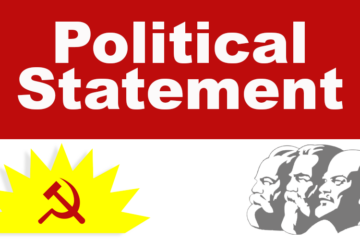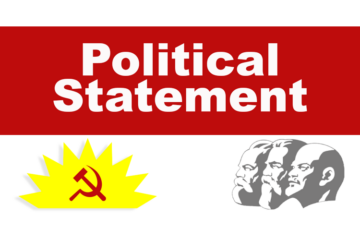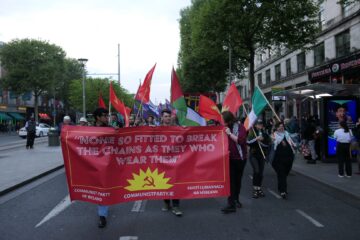In 1946 Syria won its independence in a victorious anti-colonial war that drove out the French forces. The post-colonial government followed a socialist path in pursuing development and self-reliance in the 1950s and 1960s. This was followed by a move away from socialism under Hafez al-Asad, and the full embrace of neoliberal reforms in the 2000s.
In the decades following independence Syria’s socialist policies tackled illiteracy, improved healthcare, and carried out significant land reform and redistribution programs. After the fall of the Soviet Union, Syria shed the last of its socialist policies and fell in line with the advance of global neoliberalism. By 2010 the implementation of neoliberal reforms and privatisation by Syria’s state and elites meant that the economic structures that had previously supported the basic needs of the population were coming apart at the seams, and political stability along with it.
In 2006-2007, following advice from the IMF and the World Bank, Bashar al-Asad introduced a raft of wide-ranging liberal economic reforms that had a drastic effect on workers income, as well as cutting subsidies, and undermining credit and trade policies that facilitated indigenous industries like cotton and textile production. The seeds of social unrest were steadily being sown.
Ali Kadri and Linda Matar argue that the Syrians that were implementing the reforms, letting down the nation’s political and economic safeguards, were not Syrians in working class or national terms. “They were bourgeois subordinates within the same imperialist class, headed by US-led financial capital.” That “Syria – the real home of culturally diverse working people – underwent an imperialist assault before and during the Arab Spring to tear it asunder.”[1]
The uprising in 2011 very quickly escalated primarily due to excessive use of violence by state forces. The protestors were outraged by the murder of their comrades by security forces and widespread anti-regime mobilisation aimed at the removal of the government occurred through 2011 and into 2012. Yet the ruling elite did not fracture, and a substantial proportion of security forces stayed loyal to the establishment. Both sides dug in their heels. To quote Raymond Hinnebusch, “the spilling of blood happened so quickly on such a significant scale that compromise was soon rejected on both sides.”[2] The violence provoked the turn to armed insurgency by the opposition and the government in turn engaged in counter-insurgency warfare. The escalation led to substantial defections from state forces, and the safe haven provided by Turkey and the huge volumes of support and arms being funnelled into the country by Tukey, Qatar, Saudi Arabia and the West allowed for the creation of the “Free Syrian Army”. At the same time, large numbers of non-Syrian militants were ferried into the country which contributed to the empowerment of jihadist groups like Ahrar al-Sham, Al Qaeda-linked Jabhat al-Nusra (later known as Hayat Tahir Al-Sham) and ISIS. As early as 2012 Obama initiated a covert arm and equip programme operating out of US bases in Turkey and Jordan, by 2013 the administration was talking openly about sending large flows of weapons to the opposition.[3] The civil war very quickly became a proxy war where the Western backed opposition was dominated by far-right extremist Salafist jihadist forces. As Jake Sullivan famously wrote to his State Department boss Hilary Clinton in February 2012, “AQ [Al Qaeda] is on our side in Syria.”[4]
Either Bashar al-Asad’s cards were marked, or he saw the writing on the wall when he decided to take a harsh ideological position against the 2003 US occupation of Iraq, supported the Iraqi resistance, and consolidated power while he put forward an image of Syria as a bastion of stability in a region succumbing to chaos as a result of imperialist intervention. He moved closer to Iran and Hezbollah to shift the calculus for any potential US plans for regime change in Syria. After the 2006 six-week war between Israel and Lebanon, Syria moved into position as one of the main pillars of the new formation known as the “Resistance Front”. Through increased integration of Syrian, Iranian, Hezbollah, and Palestinian Hamas military structures the calculation was to increase the cost of further Israeli aggression in the region. And when push came to shove, Iran and Hezbollah were integral to the defence of the Syrian state from the US-backed proxy war.
In Libya, NATO’s imperialist regime change war threw the country into chaos that has expanded across the region. Multiple instances of open-air slave markets have been documented, as corrupt militias rule and fight over the ruins of a once prosperous state.[5] This would likely have been Syria’s fate if the US-sponsored jihadists had not been defeated by the Syrian Arab Army. The Syrians who resisted the imperialist intervention know they are on the right side of history. To quote Matar and Kadri:
“Progressive forces have always been perfectly aware of the shortcomings of the Syrian ruling class. They have also been perfectly aware that nothing justifies siding with US-led imperialism in a war of national liberation led by the Syrian Arab Army.”[6]
Today Syria is still at war. Roughly a third of the country is occupied by Israel, Turkey, the US, and their proxies. Its developmental levels have been knocked back 70 years, and brutal unilateral US and EU sanctions are strangling the country. Malnutrition is endemic, access to water and electricity is insecure, hyperinflation is out of control. The country is continuously being bombed by the US and Israel. The people of Syria are being criminally punished for the successful resistance to the prolonged US-backed dirty war. And Syria survives to pose a challenge to US-Israeli domination in the region. A fact reconfirmed in one of the first acts of the Israeli genocidal offensive on Gaza – the simultaneous bombing of the Aleppo and Damascus airports on October 12th.[7]
– F. Wallace, CPI International Newsletter, Vol. 2 2024
[1] L. Matar, A. Kadri (eds), Syria: From National Independence to Proxy War (2019), p.6
[2] R. Hinnebusch, ‘What Went Wrong: Understanding the Trajectory of Syria’s Conflict’, ibid, p.39
[3] D. S. Cloud and R. Abdulrahim, ‘U.S. has secretly provided arms training to Syria rebels since 2012’, Los Angeles Times, June 21, 2013
[4] https://wikileaks.org/clinton-emails/emailid/23225
[5] N. Elbagir, R Razek, A Platt, and B Jones, ‘People for sale: Where lives are auctioned for $400’, CNN, Wed November 15, 2017
[6] L. Matar, A. Kadri (eds), Syria: From National Independence to Proxy War (2019), p.15
[7] ‘Syria says Israel hit Damascus, Aleppo airports again amid Gaza bombing’, Al Jazeera, 22 Oct 2023









